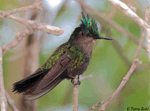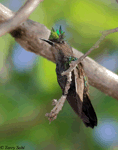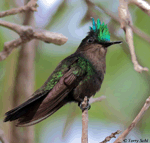| Length: 3.5 inches | Wingspan: 5 inches | Seasonality: Non-resident in South Dakota |
| ID Keys: Obvious crest, small size, greenish upperparts. Grey underparts (female), darker on male | ||
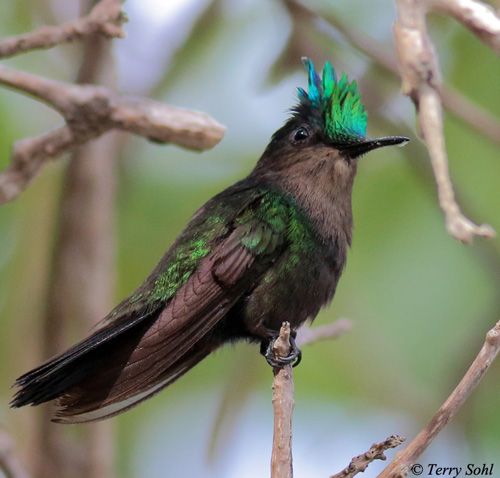 The
Antillean Crested Hummingbird is a tiny hummingbird species with a small
geographic range in the Caribbean, from eastern Puerto Rico through much of the
Lesser Antilles. In its range, it is easily identified both by the small
size and the obvious crest. In the United States it is generally unknown,
although there are a handful of disputed sightings in both Texas and Florida.
The
Antillean Crested Hummingbird is a tiny hummingbird species with a small
geographic range in the Caribbean, from eastern Puerto Rico through much of the
Lesser Antilles. In its range, it is easily identified both by the small
size and the obvious crest. In the United States it is generally unknown,
although there are a handful of disputed sightings in both Texas and Florida.
Habitat: Found in a variety of habitats, typically open, lowland areas such as forest edges and clearings, parks, and residential areas.
Diet: Feeds on both nectar and small insects.
Behavior: Forages by taking nectar from flowers, vigorously defending favored patches from rivals. They also will take insects, both by gleaning from vegetation while hovering, or by capturing insects in flight.
Nesting: The nest of an Antillean Crested Hummingbird is a small cup built of plant fibers and decorated with bits of moss, lichen, and other material, built within 3 to 10 feet of the ground in a shrub, vine, or other protected area. The female usually lays 2 eggs, and she alone incubates them. She alone feeds the young once they hatch. The young fledge after about 3 weeks.
Interactive eBird Map: Click to access an interactive eBird map of Antillean Crested Hummingbird sightings.
Song: Typical calls are weak, high-pitched chirps and thin whistles.
Migration: Considered a permanent resident throughout its normal range.
Similar Species: The obvious crest makes it rather distinctive in its normal range.
Status: The range of the Antillean Crested Hummingbird is small, but there are no perceived major threats to their overall population. The IUCN lists the Antillean Crested Hummingbird as a species of "Least Concern".
Further Information: 1) Beauty of Birds - Antillean Crested Hummingbird
2) Cornell Lab of Ornithology - Antillean Crested Hummingbird
3) Oiseaux-Birds = Antillean Crested Hummingbird
Photo Information: June 2015 - St. John's, U.S. Virgin Islands - Terry Sohl
| Click on the map below for a higher-resolution view |
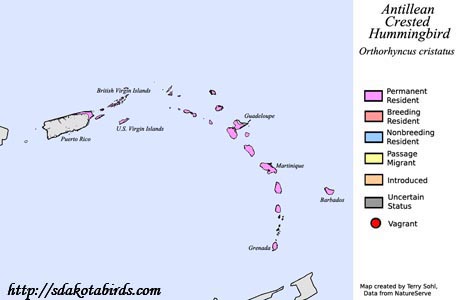 |
| South Dakota Status: Non-resident |
Additional Antillean Crested Hummingbird Photos
Click for a higher-resolution version of these photos
